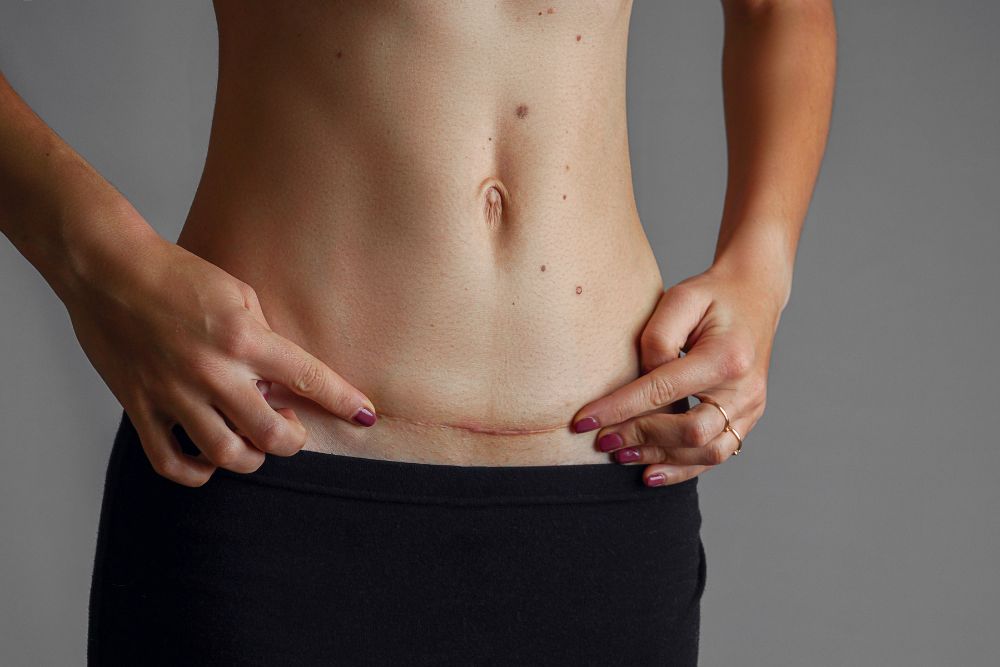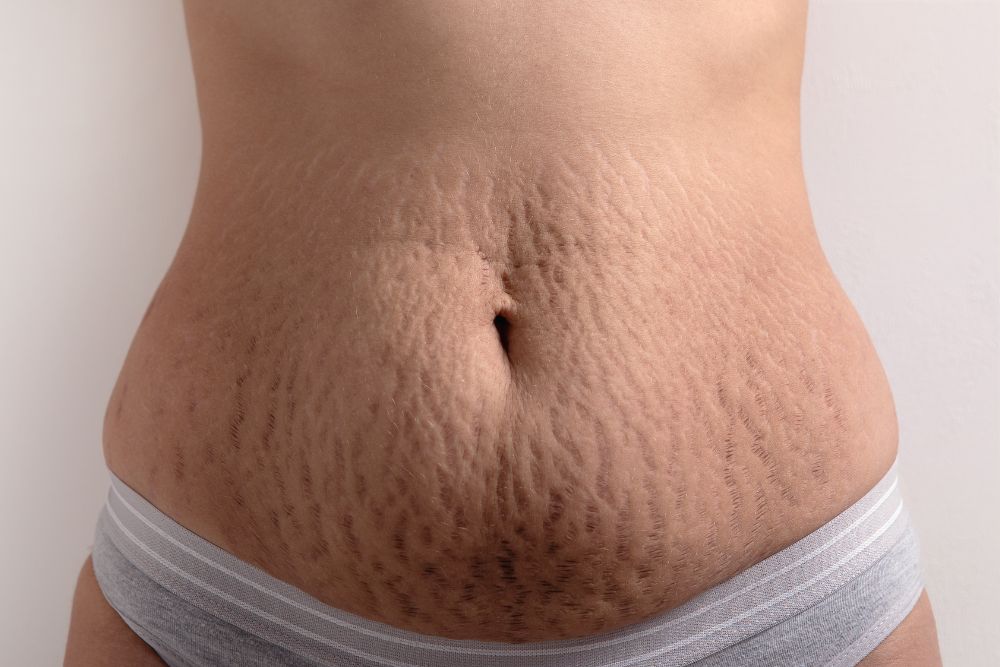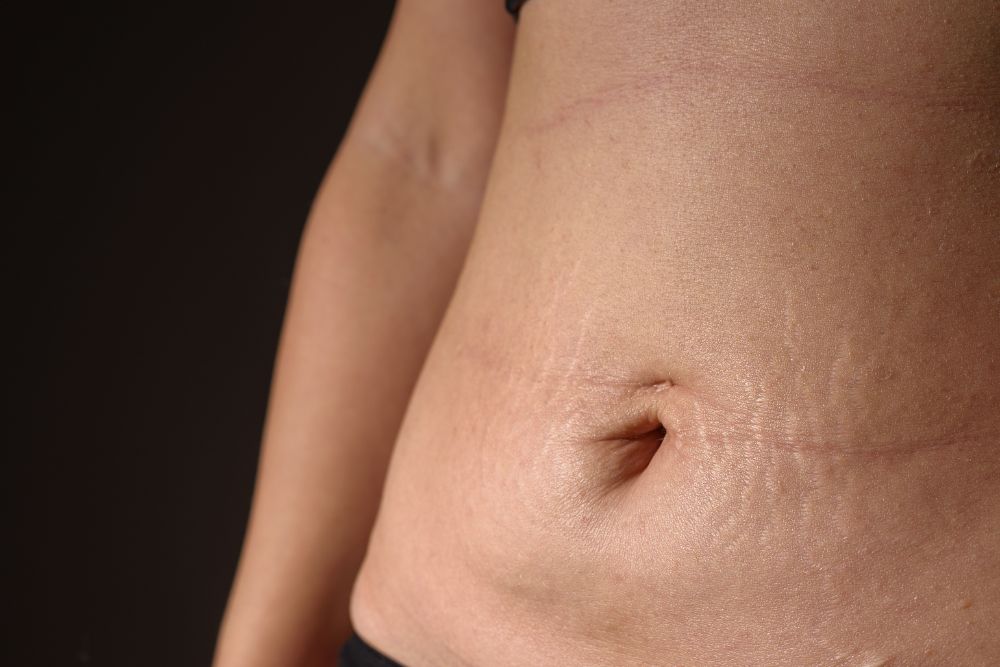Looking to remove your tummy tuck scar? You’re not alone; many people seek effective ways to reduce or eliminate the appearance of their surgical scars. In this article, we cover proven treatments and tips that can help you achieve smoother and less visible scars, including methods to remove tummy tuck scar effectively.
TL:DR
-
Tummy tuck scars, located across the lower abdomen, typically take up to two years to fade and can vary based on procedure type and individual healing factors.
-
Topical treatments like silicone sheets, Vitamin E creams, and sunscreen are essential for improving the appearance of tummy tuck scars and preventing further discoloration.
-
Advanced treatments such as laser skin resurfacing, steroid injections, and surgical scar revision may be necessary for persistent scars, emphasizing the importance of consulting qualified professionals for effective outcomes.
Understanding Tummy Tuck Scars
Scarring is an inevitable part of any surgical procedure, including the tummy tuck procedure. Typically, tummy tuck scars are located across the lower abdomen, hidden beneath the bikini line, and can take up to two years to fully settle and fade. This process is similar to what patients experience after a tummy tuck abdominoplasty.
The initial appearance of these scars is usually a thin, pink line, which, over time, becomes flatter, thinner, and lighter in color. The visibility of these scars depends on various factors, including the surgeon’s experience and individual healing processes.
Engaging an experienced plastic surgeon can significantly improve the outcome and minimize the visibility of tummy tuck scars.
Types of Tummy Tuck Scars
 Different types of tummy tuck procedures result in different scar patterns. A full tummy tuck typically leaves a longer, low-lying scar from hipbone to hipbone, often accompanied by a small circular scar around the newly created navel.
Different types of tummy tuck procedures result in different scar patterns. A full tummy tuck typically leaves a longer, low-lying scar from hipbone to hipbone, often accompanied by a small circular scar around the newly created navel.
On the other hand, a mini tummy tuck results in a shorter, horizontal scar below the belly button, which is usually well-hidden by swimwear. Extended tummy tuck incisions may involve longer scars that follow the body’s natural contours around the hips.
Understanding these variations helps set realistic expectations about the scarring that accompanies each type of tummy tuck.
Healing Phases of Tummy Tuck Scars
The healing process of tummy tuck scars occurs in several stages. Initially, during the inflammatory phase, the scar appears red and somewhat prominent due to collagen formation.
This phase is followed by the maturation phase, where the scar gradually flattens, changes color, and becomes less noticeable over time. This process can take a year or more, but with proper care and treatments, scars can eventually fade to a fine line.
Topical Treatments for Tummy Tuck Scars
 To enhance the appearance of tummy tuck scars, various topical treatments are available. These treatments include silicone sheets and gels, scar creams with Vitamin E, and the use of sunscreen to protect scars from UV damage.
To enhance the appearance of tummy tuck scars, various topical treatments are available. These treatments include silicone sheets and gels, scar creams with Vitamin E, and the use of sunscreen to protect scars from UV damage.
Each of these options plays a vital role in managing scar tissue and promoting better healing outcomes.
Silicone Sheets and Gels
Silicone sheets and gels are popular choices for managing tummy tuck scars. These products help maintain moisture in the scar tissue, which can prevent excess collagen production and reduce the appearance of scars.
Silicone sheets can be applied overnight, creating an optimal healing environment, while silicone gels can be used multiple times a day to keep the scar hydrated and minimize related symptoms like itchiness.
Scar Creams with Vitamin E
Vitamin E is well-known for its skin healing properties and is often included in scar creams to improve the appearance of scars. Massaging Vitamin E oil into the healing scars can help them fade over time, especially if used consistently for at least the first two months.
Combining Vitamin E application with gentle massage enhances the healing process and improves the scar’s texture.
Sunscreen for Scar Protection
Using sunscreen is crucial for protecting tummy tuck scars from UV damage, which can cause pigmentation changes and make scars more noticeable. Applying sunscreen with at least SPF 30 should be a part of your daily routine for 12 to 18 months post-surgery to ensure proper protection and minimize scarring.
Advanced Scar Removal Treatments
 For those with more severe or persistent scars, advanced scar removal treatments might be necessary. These treatments include laser skin resurfacing, steroid injections, and skin needling, each offering different benefits for improving the appearance of tummy tuck scars.
For those with more severe or persistent scars, advanced scar removal treatments might be necessary. These treatments include laser skin resurfacing, steroid injections, and skin needling, each offering different benefits for improving the appearance of tummy tuck scars.
Laser Skin Resurfacing
Laser skin resurfacing is a long-term treatment that reduces the visibility of tummy tuck scars by stimulating new skin cell growth. This procedure involves using light or heat to promote healing and improve skin texture. Consulting a board-certified plastic surgeon is essential to ensure safe and effective results. Additionally, laser treatments can enhance the overall outcome of the procedure.
While laser resurfacing can significantly reduce the appearance of scars, it does not completely remove them.
Steroid Injections
Steroid injections are another effective treatment for thick, red, or raised scars, such as hypertrophic and keloid scars. These injections can be administered at the time of surgery or a few weeks post-surgery to improve scar appearance.
The cost of steroid treatments varies depending on the severity of the scar treatments.
Skin Needling
Skin needling, also known as microneedling, is a minimally invasive procedure that uses fine needles to create micro-injuries in the skin, stimulating the body’s natural healing process. This process triggers collagen and elastin production, which are crucial for skin repair and improving skin texture.
Consulting a qualified professional is important to ensure safe and effective results.
Surgical Options for Tummy Tuck Scar Revision
In some cases, surgical options might be required to improve the appearance of tummy tuck scars. Corrective tummy tuck surgery can address unsightly scars, offering various techniques to enhance both functionality and aesthetics.
Surgical Scar Revision
Surgical scar revision involves techniques such as progressive tension suturing, serial excision, and tissue expansion to improve the appearance of tummy tuck scars. This process may combine creams, less-invasive procedures, and minor surgery to achieve the desired results.
Timing for Scar Revision Surgery
Timing is crucial for scar revision surgery, with the ideal period being around 12 to 18 months post-surgery to allow scars to mature. This waiting period ensures optimal healing and better outcomes from the revision surgery.
Home Remedies and Lifestyle Changes
Lifestyle changes and home remedies can significantly impact the healing process and appearance of tummy tuck scars. Factors such as genetics, nutrition, and stress management play crucial roles in scar healing.
Massage Therapy
Regular massage therapy can improve circulation around the scar, promoting better healing. Gently massaging the scar after 2 to 3 weeks can enhance blood flow and aid in breaking up scar tissue.
Healthy Diet and Hydration
A healthy diet and proper hydration are vital for wound healing and skin health. Good nutrition provides essential nutrients needed for tissue repair, while hydration helps maintain skin elasticity, both of which are crucial for effective scar healing.
Avoiding Smoking and Stress
Avoiding smoking and managing stress are critical for optimal scar healing. Smoking cessation improves blood circulation, while stress management supports the body’s healing processes.
Preventing Tummy Tuck Scars
Preventing tummy tuck scars involves several proactive measures, including following aftercare instructions, avoiding sun exposure, using silicone sheets or gels, and maintaining a healthy lifestyle.
Following Postoperative Care Instructions
Adhering to postoperative care instructions is essential for minimizing scar visibility and promoting better healing. Following your surgeon’s specific care instructions, including how to care for the belly button during recovery, can lead to minimal scarring.
Proper Wound Care
Proper wound care is crucial for scar healing. Silicone treatments should only be applied after the scar wound has completely closed to avoid infection and promote healing.
Avoiding sun exposure is also important to prevent pigmentation changes.
Gradual Return to Activities
A gradual return to activities is necessary to avoid straining the healing incisions. Patients should refrain from heavy activities for 4 to 8 weeks post-surgery, ensuring a cautious approach to physical activities to promote proper healing.
Summary
Managing and preventing tummy tuck scars requires a comprehensive approach, including topical treatments, advanced removal procedures, surgical options, and lifestyle changes. Understanding the types and healing phases of scars can set realistic expectations and guide appropriate care.
Employing methods such as silicone sheets, Vitamin E creams, and sunscreen can significantly improve scar appearance. For more persistent scars, advanced treatments like laser resurfacing, steroid injections, and skin needling offer effective solutions. Surgical revision might be necessary for severe cases, with timing playing a crucial role in achieving optimal results.
Incorporating home remedies and lifestyle adjustments, such as massage therapy, a healthy diet, and avoiding smoking, supports the healing process. By following postoperative care instructions and proper wound care, you can minimize scarring and enjoy the benefits of your tummy tuck with confidence.
Frequently Asked Questions
How long does it take for tummy tuck scars to fade?
Tummy tuck scars can take up to two years to fully fade. Initially, they will appear as thin, pink lines before gradually becoming flatter and lighter in color.
What are the best topical treatments for tummy tuck scars?
The best topical treatments for tummy tuck scars are silicone sheets or gels, scar creams containing Vitamin E, and sunscreen with at least SPF 30 to shield scars from UV damage. Implementing these treatments can significantly improve the appearance of scars.
When should I consider surgical scar revision for my tummy tuck scars?
You should consider surgical scar revision for your tummy tuck scars 12 to 18 months after the surgery, as this timeframe allows the scars to mature and promotes optimal healing.
How can I prevent my tummy tuck scars from becoming more noticeable?
To prevent your tummy tuck scars from becoming more noticeable, adhere to postoperative care instructions, utilize silicone sheets or gels, avoid sun exposure, and maintain a healthy lifestyle. These measures will significantly help in minimizing scar visibility.
Are advanced scar removal treatments like laser resurfacing effective for tummy tuck scars?
Advanced treatments such as laser skin resurfacing are indeed effective in reducing the visibility of tummy tuck scars by promoting new skin cell growth and healing, though complete removal may not be possible.

